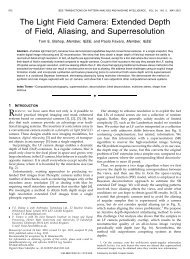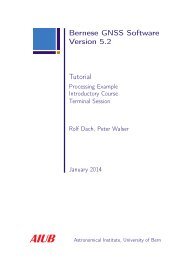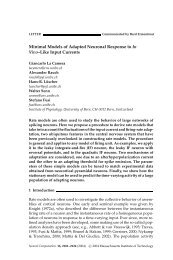Simon Peter's Mother in Law Revisited. Or Why One Should Be More
Simon Peter's Mother in Law Revisited. Or Why One Should Be More
Simon Peter's Mother in Law Revisited. Or Why One Should Be More
- No tags were found...
Create successful ePaper yourself
Turn your PDF publications into a flip-book with our unique Google optimized e-Paper software.
© Smit, Peter’s <strong>Mother</strong> <strong>in</strong> <strong>Law</strong> lectio difficilior http://www.lectio.unibe.ch/03_1/smit.htm4 See note 8.5 Deborah Krause, ‘<strong>Mother</strong>-<strong>in</strong>-<strong>Law</strong>,’ 39.6 Ibid., 39. This is a quotation from Elisabeth Schüssler-Fiorenza, Bread Not Stone: The Challenge of Fem<strong>in</strong>istBiblical Interpretation (Boston, MA: <strong>Be</strong>acon Press, 1984), 15.7 Krause, ‘<strong>Mother</strong>-<strong>in</strong>-<strong>Law</strong>, 41. The quotation is taken from Mary Ann Tolbert, ‘Protestant Fem<strong>in</strong>istHermeneutics and the Bible: On the Horns of a Dilemma,’ <strong>in</strong>: Alice Bach (ed.), The Pleasure of Her Text:Fem<strong>in</strong>ist Read<strong>in</strong>gs of Biblical and Historical Texts (Valley Forge, PA: Tr<strong>in</strong>ity Press International, 1990), 15. Seealso: http://www.religion-onl<strong>in</strong>e.org/cgi-b<strong>in</strong>/relsearchd.dll/showchapter?chapter_id=1779. Tolbert quotesPatroc<strong>in</strong>io P. Schweichart, ‘Read<strong>in</strong>g Ourselves: Toward a Fem<strong>in</strong>ist Theory of Read<strong>in</strong>g’, <strong>in</strong>: Patroc<strong>in</strong>io P.Schweichart / Elizabeth A. Flynn, Gender and Read<strong>in</strong>g, Essays on Readers, Texts, and Contexts (Baltimore:John Hopk<strong>in</strong>s University Press, 1986), 31-62, the reference is found on 43-44.8 Krause, ‘<strong>Mother</strong>-<strong>in</strong>-<strong>Law</strong>,’ 41. See Mary Ann Tolbert, ‘Mark,’ <strong>in</strong>: C.A. Newsom and S.H. R<strong>in</strong>ge (eds.), TheWomen’s Bible Commentary (Louisville: Westm<strong>in</strong>ster/John Knox Press, 1992), 263-274, esp. 267; LuiseSchottroff, ‘Women as Disciples of Jesus <strong>in</strong> New Testament Times,’ <strong>in</strong>: Idem, Let the Oppressed Go Free:Fem<strong>in</strong>ist Perspectives on the New Testament (Louisville: Westm<strong>in</strong>ster/John Knox Press, 1993), 80-118;Elisabeth Schüssler Fiorenza, In Memory of Her: A Fem<strong>in</strong>ist Theological Reconstruction of Christian <strong>Or</strong>ig<strong>in</strong>s(New York: Crossroad, 1983), 320-321.9 Krause, ‘<strong>Mother</strong>-<strong>in</strong>-<strong>Law</strong>,’ 41.10 Krause, ‘<strong>Mother</strong>-<strong>in</strong>-<strong>Law</strong>,’ 42.11 Krause, ‘<strong>Mother</strong>-<strong>in</strong>-<strong>Law</strong>,’ 42-43. Bultmann is the only German scholar mentioned by Krause, but he is notnecessarily representative of ma<strong>in</strong>stream traditional German (or cont<strong>in</strong>ental) historical-critical scholarship.However, her f<strong>in</strong>d<strong>in</strong>gs are confirmed by the follow<strong>in</strong>g commentaries: Rudolf Pesch, Das Markusevangelium(Herders Theologischer Kommentar zum Neuen Testament II/1; Herder: Freiburg, 2001 [1976]), 129ff. See alsoGerd Theissen, Urchristliche Wundergeschichten (Gütersloh: Gütersloher Verlagshaus, 1974), 75. Pesch alsoviews the service of <strong>Simon</strong> Peter’s mother-<strong>in</strong>-law from the perspective of the theological theme of service with<strong>in</strong>the Gospel of Mark (Pesch, Markusevangelium, 132). The fem<strong>in</strong>ist perspective, therefore, builds to a certa<strong>in</strong>extent on traditional historical-critical research. In Stephen C. Barton, Discipleship and Family Ties <strong>in</strong> Mark andMatthew (Society of New Testament Studies, Monograph Series 80; Cambridge: Cambridge University Press,1994), the subject is unfortunately not dealt with, although the fact that some or at least one of the disciples leftbeh<strong>in</strong>d a family could shed some light on the family ties of Jesus’ earliest followers as well. Also OscarCullmann, Petrus, Jünger, Apostel Martyrer (Siebenstern Taschenbuch; München: Siebenstern TaschenbuchVerlag, 1967), 22, simply rem<strong>in</strong>ds the reader of the established fact that Peter was married and took his wifewith him on his missionary journeys. See also Christfried Böttrich, Petrus, Fischer, Fels und Funktionär(Leipzig: Evangelische Verlagsanstalt, 2001), 36ff. His compla<strong>in</strong>t that we f<strong>in</strong>d only scattered remarks about<strong>Simon</strong> Peter’s family life is, <strong>in</strong> my view, unjustified, because we know far more about him than about any otherof the twelve. Important is that he pays attention to the wife of Peter (miss<strong>in</strong>g <strong>in</strong> most other contributions to thediscussion) on the basis of Mark 10:28-30 and 1 Peter 5:13. As Cullmann and others he also refers later legendsabout Peter to the dustb<strong>in</strong>, but this is only partly justified, because these legends may also po<strong>in</strong>t towards a ratherdifferent ideology of priesthood <strong>in</strong> ma<strong>in</strong>stream Christianity than is the case nowadays. Both Robert Guelich(Mark 1-8:26, Word Biblical Commentary 34A; Dallas: Word Books , 1989, 61-63) and Pheme Perk<strong>in</strong>s, (Peter:9
















